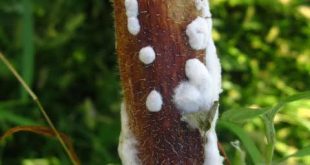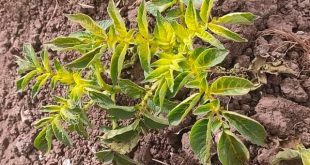ا. د. محمد المليجي
 مرض فطري يسببه الفطر Alternaria tomatophilai (formerly A. solani) والذي يسبب اللفحة المتأخرة في البطاطس ويصيب البزنجان ونباتات أخري، ينتقل الفطر من البذور نادرا ولكن مصدره الأساسي هو بقايا المحاصيل المصابة وحشائش العائلة البازنجانية كما ينتقل مع الدرنات المصابة
مرض فطري يسببه الفطر Alternaria tomatophilai (formerly A. solani) والذي يسبب اللفحة المتأخرة في البطاطس ويصيب البزنجان ونباتات أخري، ينتقل الفطر من البذور نادرا ولكن مصدره الأساسي هو بقايا المحاصيل المصابة وحشائش العائلة البازنجانية كما ينتقل مع الدرنات المصابة
الأعراض: بقع صغيرة بنية غير منتظمة في البداية علي الأوراق الأكبر سنا اولا ثم تتسع البقع وتكون حلقات مركزية وتنتشر علي معظم اعضاء النبات وتكون انسجة الورقة حول البقع صفراء وقد تصفر الأوراق وتسقط. تتكون علي الثمار بقع قاتمة جلدية غائرة
المكافحة:
يجب اتباع دورة زراعيه مدتها 3-4 سنوات تتبادل بها البطاطس والطماطم مع محاصيل لا تصاب بالمرض مع استخدام درنات وبذور خالية من المرض وازالة بقايا المحصول السابق. وتستخدم المبيدات الفطرية بانتظام لمكافحة المرض وقائيا باتباع برنامج مخصص لمكافحة المرض
Cause: Alternaria tomatophilai (formerly A. solani), a fungus that also causes early blight of potato and attacks eggplant, horsenettle, nightshade, and other wild plants related to tomato. The fungus may be on or in seed, but internal infection is rare in seed produced commercially. The fungus can survive on infected plant refuse in soil or overwinter on solanaceous plants. Infection is favored by temperatures of 75 to 84°F, high mois-ture, and low soil fertility.
Symptoms: Small, irregular, blackish brown spots usually first appear on older leaves. Spots enlarge to 0.25 to 0.5 inch in diameter, and they commonly show ridged concentric rings in a target pattern. Leaf tissue around the spots turns yellow. If spots are numerous, the entire leaf will be yellowed. Some spotting may be on older leaves early in the season, but the greatest injury usually is as fruit begins to mature. Defoliation may be severe if environmental conditions are favorable, exposing the fruit to sun scald.
Older fruit develop dark, leathery, sunken spots that may be quite large with concentric markings similar to those on diseased leaves. The dark, dry decay may extend to some depth into the fruit. Infected mature or immature fruit frequently fall from the plant.
Seedlings may have circular or elongated lesions with concentric markings on the stem which will girdle the plant. This symptom is known as collar rot
 Plant Health Plant Diseases and Pests and their Management
Plant Health Plant Diseases and Pests and their Management





